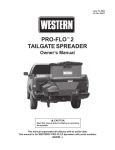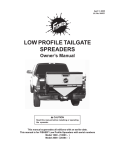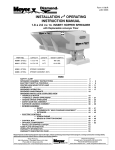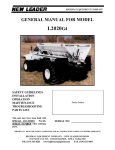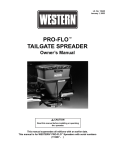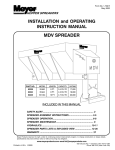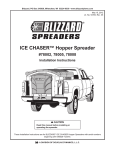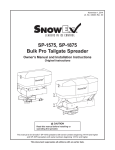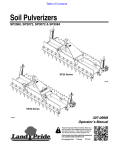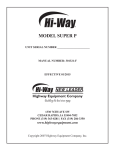Download Western PRO-FLO 2 Owner`s manual
Transcript
Form No. 13721 March 1999 ® PRO-FLO™ 2 TAILGATE SPREADER Owner’s Manual CAUTION Read this manual before installing or operating the spreader. This manual is for WESTERN® PRO-FLO™2 Spreaders with serial numbers (202389 - ) TABLE OF CONTENTS PREFACE ................................................................. 1 SAFETY INFORMATION ........................................... 2 Before You Begin ................................................ 2 Torque Chart ....................................................... 2 Warning/Caution Label ........................................ 3 Under-Frame Mount Assembly Labels ................ 4 LOADING .................................................................. 5 Load Weights ..................................................... 5 Approximate Salt Weight ................................... 5 Certification ........................................................ 5 Approximate Sand Weight ................................. 5 MOUNTING THE SPREADER ................................... 6 In-Bed Mount ...................................................... 6 Under-Frame Mount ............................................ 7 OPERATING THE SPREADER ................................. 9 Adjusting the Gates and the Deflector ................. 9 Deflector Effect ................................................... 9 OPERATING THE SPREADER ................................ 10 PWM Control ..................................................... 10 Starting and Stopping the Motor ......................... 10 Adjusting the Spinner Speed .............................. 10 Blast/Maximum Speed ....................................... 10 Spinner Indicator Lights ...................................... 10 Single Speed Control ......................................... 11 Starting and Stopping the Motor ......................... 11 Blast Position .................................................... 11 REMOVING THE SPREADER ................................. 12 In-bed Mount ...................................................... 12 Under-Frame Mount ........................................... 13 Form No. 13721 RECEIVER HITCH ................................................... 14 Safety ................................................................ 14 Important Information on Towing ......................... 14 Ball Mounts/Drawbars ........................................ 14 Hitch Balls ......................................................... 14 Trailer Couplers .................................................. 14 Safety Chains .................................................... 14 Electrical Connections ....................................... 14 Sway Controls ................................................... 15 Other Useful Equipment ..................................... 15 Tire Inflation ....................................................... 15 Equipment and Parts Check .............................. 15 No Passengers in Trailers! ................................. 15 Trailer Loading ................................................... 15 Driving ................................................................ 15 Excessive Sway ................................................ 15 Controlling Trailer Sway ..................................... 15 MAINTENANCE ....................................................... 16 After each use: .................................................. 16 At the end of each season ................................. 16 WIRING DIAGRAM .................................................. 17 TROUBLESHOOTING GUIDE .................................. 18 PWM (Variable Speed) Control ........................... 18 On-Off (Single Speed) Control ............................ 19 Mechanical Problems ........................................ 20 iii March 1999 PREFACE This manual has been prepared to acquaint you with the safety information, operation and maintenance of your new tailgate spreader. Please read this manual carefully and follow all recommendations. This will help ensure profitable and trouble-free operation of your spreader. Keep this manual accessible. It is a handy reference in case minor service is required. Form No. 13721 When service is necessary, bring your spreader to your local outlet. They know your spreader best and are interested in your complete satisfaction. NOTE: This spreader is designed to spread snow and ice control materials only. Do not use it for purposes other than those specified in this manual. 1 March 1999 SAFETY INFORMATION CAUTION WARNING • Indicates a potentially hazardous situation that, if not avoided, could result in death or personal injury. • CAUTION • Indicates a situation that, if not avoided, could result in minor personal injury and/or damage to product or property. • • NOTE: Identifies tips, helpful hints and maintenance information the owner/operator should know. CAUTION Disconnect electric power before servicing or performing maintenance. Before You Begin • Park the vehicle on a level surface, place shift lever in PARK or NEUTRAL and set the parking brake. CAUTION DO NOT leave unused material in hopper. Material can freeze or solidify, causing unit to not work properly. Empty and clean after each use. WARNING • • • • • Driver to keep bystanders minimum of 25 feet away from operating spreader. Before working with the spreader, secure all loose-fitting clothing and unrestrained hair. Before operating the spreader, verify all safety guards are in place. Before servicing the spreader, wait for conveyor or spinner to stop. Do not climb into or ride on spreader. NOTE: Maintain proper belt tension for correct belt functioning. NOTE: Lubricate grease fittings after each use. Use a low temperature synthetic grease. When tightening fasteners, refer to Torque Chart for the recommended fastener values. WARNING Torque Chart Overloading could result in an accident or damage. Do not exceed GVWR or GAWR ratings as found on the driver-side door cornerpost of the vehicle. See Loading Section to determine maximum volumes of spreading material. NC FASTENER TORQUE (FT-LB) GRADE DIAMETERTHREADS G2 G5 1/4 - 20 6 9 13 5/16 - 18 11 18 28 46 PER INCH CAUTION If rear directional, CHMSL light or brake stoplights are obstructed by the spreader, the lights shall be relocated, or auxiliary directional or brake stoplights shall be installed. March 1999 Do not operate a spreader in need of maintenance. Before operating the spreader, reassemble any parts or hardware removed for cleaning or adjusting. Before operating the spreader, remove materials such as cleaning rags, brushes, and hand tools from the spreader. While operating the spreader, use auxiliary warning lights, except when prohibited by law. Tighten all fasteners according to the Torque Chart. Refer to Torque Chart for the recommended torque values. 2 G8 3/8 - 16 19 31 7/16 - 14 30 50 75 1/2 - 13 45 75 115 9/16 - 12 66 110 165 5/8 - 11 93 150 225 3/4 - 10 150 250 370 7/8 - 9 150 378 591 1-8 220 893 583 Form No. 13721 SAFETY INFORMATION Please become familiar with the Warning and Caution labels on the spreader! Caution Label CAUTION Do not lift spreader by wire channel. This could cause product damage and/or personal injury. 67272 Warning/Caution Label (Both Sides) WAR NING CAUT ION Warning/Caution Label WARNING CAUTION DO NOT EXCEED GVWR OR GAWR WITH SPREADER AND LOAD. TURN SPREADER OFF BEFORE FILLING, ADJUSTING, OR CLEANING. BYSTANDERS TO STAY A MINIMUM OF 25 FEET AWAY FROM OPERATING SPREADER. DO NOT CLIMB INTO OR RIDE ON SPREADER. KEEP HANDS, FEET, CLOTHING AWAY FROM MOVING CONVEYOR AND SPINNER. Form No. 13721 READ OWNER'S MANUAL BEFORE OPERATING OR SERVICING SPREADER. EMPTY AND CLEAN SPREADER AFTER EACH USE. 68584 3 March 1999 SAFETY INFORMATION Under-Frame Mount Assembly Labels The diagram below indicates the location of the safety and identification labels. HITCH TYPE WEIGHT DISTRIBUTING MAX. GROSS MAX. TRAILER TONGUE WEIGHT (LB.) WEIGHT (LB.) 10,000 WARNING DO NOT cut, drill, weld or modify this tube 1,000 67182 WEIGHT CARRYING BALL MOUNT 10,000 1,000 67181 March 1999 4 Form No. 13721 LOADING Certification This Manual covers vehicles which have been recommended for carrying the spreader. The following vehicles are recommended: All new untitled vehicle installations require National Highway Traffic Safety Aministration (NHTSA) Altered Vehicle Certification Labeling. Installer to verify struck load of snow or ice control material does not exceed vehicle GVWR or GAWR ratings. • All Ford Light Duty F-Series trucks over 6000 lb. GVWR • All Chevrolet/GMC Light Duty pick-up trucks over 6000 lb. GVWR • All Dodge pickup trucks over 5800 lb. GVWR WARNING WARNING Overloading could result in an accident or damage. Do not exceed GVWR or GAWR ratings as found on the driver-side cornerpost of the vehicle. The use of under-frame or in-bed mounts on half-ton trucks is restricted to spreading only salt or calcium chloride. (max. 70 lb. per cu. ft.) Failure to comply could result in exceeding the payload capacity. Load Weights Approximate Salt Weight Salt = 70 lb./ft Approximate Sand Weight 700 lb. 10 ft.3 950 lb. 10 ft.3 273 lb. 3.9 ft.3 371 lb. 3.9 ft.3 3 Sand = 95 lb./ft3 Plus Approximate Base Unit Weight of 355 Lbs. Including Mount Form No. 13721 5 March 1999 MOUNTING THE SPREADER In-Bed Mount 5. Lift the hopper assembly using a hoist or two people, and tip slightly forward. 1. Remove the tailgate from the vehicle. 2. Place the mount assembly into the bed of the vehicle. 3. Slide the assembly forward engaging the locator studs. Locator Studs Mount Assembly 6. Position the tabs of the hopper assembly over the top of the mount assembly, and lower. Tab 4. Secure the front of the mount assembly to the channel using hold-down bolts. Hand tighten. Hold-down Bolt 7. Allow the hopper assembly to lower into position. NOTE: Apply a small amount of grease to the bolt thread periodically to ensure easy removal. March 1999 6 Form No. 13721 MOUNTING THE SPREADER 8. Insert hold-down pins and secure with hairpin cotter pins. Under-Frame Mount 1. Install the secondary frame into the subframe. Hairpin Cotter Pin Hold-down Pin Secondary Frame Subframe 2. Insert the hitch pin on each side, and secure with linch pins. CAUTION Both hold-down pins must be in place and secured with hairpin cotter pins. The hopper assembly may become unstable if the pins are not properly secure while the vehicle is in motion. 9. Connect the spreader wiring harness to the vehicle wiring harness. Spreader Wiring Harness Hitch Pin Vehicle Wiring Harness 10. Verify vehicle stoplights and spreader center high mounted stoplight are working properly. NOTE: Grease all electrical connections with dielectric grease. Form No. 13721 7 March 1999 MOUNTING THE SPREADER 5. Insert pin on each side and secure with hairpin cotter pin. 3. Lift the hopper assembly using a hoist or two people, and tip slightly forward. Hairpin Cotter Pin Hold-down Pin 4. Position tabs on the hopper assembly over the top of the mount assembly, and lower the assembly. CAUTION Both hold-down pins must be in place and secured with hairpin cotter pins. The hopper assembly may become unstable if the pins are not properly secure while the vehicle is in motion. 6. Connect spreader wiring harness to the vehicle wiring harness. Spreader Wiring Harness Vehicle Wiring Harness NOTE: Grease all electrical connections with dielectric grease. 7. Verify vehicle stoplights and spreader center high mounted stoplight are working properly. March 1999 8 Form No. 13721 OPERATING THE SPREADER Adjusting the Gates and the Deflector Spread pattern, pattern width, and the amount of material dispensed are dependent on the spinner speed, gate position, and deflector position. WARNING Before making any adjustments to the gate/ deflector settings, always turn the power off. Deflector Effect Driver side open. Passenger side open. Both sides open. Form No. 13721 9 March 1999 OPERATING THE SPREADER Adjusting the Spinner Speed There are two control options. They include the PWM Control and the Single Speed Control. The speed setting can be adjusted when the spreader is either on or off. PWM Control 5 4 6 START BLAST OFF Power Switch Used to start and stop the spinner 8 2 1 ON SPINNER 1. Turn the speed dial clockwise. As the numbers on the speed dial increase, so will the speed. 7 3 2. Turn the speed dial counterclockwise. As the numbers on the speed dial decrease, so will the speed. 9 MIN MAX SPEED PATENT PENDING Blast/Maximum Speed 1. Press and hold the power switch to the START/ BLAST position for as long as maximum speed is needed. Speed Dial Used to change the speed of the spinner NOTE: If speed dial is set to max, pressing the blast button will not affect spinner speed. Indicator Lights Indicate whether the spinner is in motion. Left light is red and indicates a fault. Right light is green and indicates power is on. 2. Release the power switch when maximum speed is no longer needed. When released, it will automatically return to the ON position and to the speed shown on the speed dial. Starting and Stopping the Motor NOTE: When blast is used, the speed dial will remain at the preset speed and will not move to the maximum speed setting. WARNING Before starting the motor, be sure all personnel and equipment are clear of the discharge area. Spinner Indicator Lights Two lights on the cab control indicate the status of the motor: 1. To start the spreader motor, press the power switch to the START/BLAST position and release. This is a momentary position and the power switch will automatically return to the ON position when released. The spreader will operate at the speed selected on the speed dial. 2. Press the power switch to the OFF position to stop the motor. The power switch will remain in this position. Left light is red and indicates a fault. When the red (left) light is on, the power is on and the motor is not running. • Right light is green and indicates power is on. When the green (right) light is on, there is power to the controller and the motor is running. If there are problems while operating the spreader, refer to the Troubleshooting section of this manual. NOTE: The truck ignition must be on to start the spreader. NOTE: Always place the vinyl cover over the hopper to prevent moisture buildup. Do not let the spreader sit idle with material in the hopper for an extended period of time. This can cause the material to compact and reduce or stop the flow of material. NOTE: If the truck ignition is turned off while the spreader is running, the motor will stop. March 1999 • 10 Form No. 13721 OPERATING THE SPREADER Single Speed Control ON OFF BLAST On/Off Control Switch Used to start and stop the spinner. SPINNER Spinner Indicator Light Illuminated light Indicates power to the motor. Starting and Stopping the Motor WARNING NOTE: The truck ignition must be on to start the spreader. Before starting the motor, be sure all personnel and equipment are clear of the discharge area. NOTE: If the truck ignition is turned off while the spreader is running, the motor will stop. 1. Move the power switch to the on position to start the motor. Motor will start immediately. The power switch will remain in this position. If there are problems while operating the spreader, refer to the Troubleshooting section in this manual. 2. Move the power switch to the OFF position to stop the motor. The power switch will remain in this position. NOTE: Always place the vinyl cover over the hopper to prevent moisture buildup. Do not let the spreader sit idle with material in the hopper for an extended period of time. This can cause the material to compact and reduce or stop the flow of material. Blast Position Move and hold the power switch to the BLAST position for as long as momentary operation is needed. When released, the switch will automatically return to the OFF position and stop the motor. Form No. 13721 11 March 1999 REMOVING THE SPREADER In-bed Mount 4. Using a hoist or two people, tip the hopper assembly forward and lift it off of the mount assembly. NOTE: Empty the hopper before removing the spreader. 1. Disconnect the spreader wiring harness from the vehicle wiring harness. Spreader Wiring Harness 5. Loosen and remove the hold-down bolts from the front of the mount assembly. Vehicle Wiring Harness Hold-down Bolt NOTE: Grease the electrical connections using dielectric grease. 2. Install the plug cover over the vehicle harness plug. 3. Remove the hairpin cotter pins and hold-down pins. Hairpin Cotter Pin 6. Remove the mount assembly from the vehicle. Hold-down Pin March 1999 7. Install the tailgate. 12 Form No. 13721 REMOVING THE SPREADER Under-Frame Mount 4. Tip the hopper assembly forward and lift it off of the mount assembly. NOTE: Empty the hopper before removing the spreader. 1. Disconnect the spreader wiring harness from the vehicle wiring harness. Spreader Wiring Harness 5. Remove the linchpins and hitch pins retaining the secondary frame. Vehicle Wiring Harness NOTE: Grease the electrical connections using dielectric grease. 2. Install the plug cover over the vehicle harness plug. 3. Remove the hairpin cotter pins and the hold-down pins. Hairpin Cotter Pin Hitch Pin 6. Remove the secondary frame assembly from the subframe. Hold-down Pin Secondary Frame Subframe Form No. 13721 13 March 1999 RECEIVER HITCH Safety Ball Mounts/Drawbars WARNING • • • • Do not overload any part of your towing system. Do not modify your hitch. Install only on specified vehicles which are in good condition. This product is designed to tow trailers. Do not use as cargo carriers, motorcycle carriers, boat hoists, or coupler alignment devices. Do not use as a jacking point. Do not attach anything with or in place of the ball. Do not pull multiple trailers. Towing one trailer behind another may cause severe instability and loss of control. Important Information on Towing Make sure all operators of your equipment read and understand this information before towing. This information will help you properly select, use, and maintain your towing equipment. Learn the capabilities and limitations of each part. CAUTION Never exceed the gross trailer weight or tongue weight of this equipment. Never exceed the lowest weight rating of any part of your towing system. See the Label information (rating) area in the Safety Section of this manual. Select these products by their gross trailer weight and tongue weight ratings. Select hitches and receivers for specific vehicles. Do not purchase a ball mount or drawbar which will give more than a four inch drop or seven inch extension as measured from the lower rear edge of the receiver. Hitch Balls Select by gross trailer weight rating, coupler socket size, and mounting platform thickness and hole size. Hole must not exceed threaded shank diameter by more than 1/16 inch. Use lock washer. Tighten according to instructions. When tightened, shank must protrude beyond bottom of nut. Gross trailer weight rating and ball diameter are marked on balls. Trailer Couplers The coupler socket should be smooth, clean and lightly lubricated. Tighten or adjust according to the coupler manufacturer’s instructions. Safety Chains Connect safety chains properly every time you tow. Cross chains under coupler. Attach securely to the hitch or tow vehicle so they cannot bounce loose. Leave only enough slack to permit full turning. Too much slack may prevent chains from maintaining control if other connections separate. Do not allow chains to drag on the road. Electrical Connections Gross trailer weight is the weight of the trailer plus the weight of the cargo. Measure gross trailer weight by putting the fully loaded trailer on a vehicle scale. Tongue weight is measured by placing the fully loaded trailer on a level surface with the coupler at normal towing height. Use a commercial scale to measure the weight at the coupler. March 1999 Make these safety-critical connections every time you tow, no matter how short the trip. Check operation, including electric brake manual control, before getting on the road. 14 Form No. 13721 RECEIVER HITCH Sway Controls Driving Sway controls can lessen the effects of sudden maneuvers, wind gusts, and buffeting caused by other vehicles. We recommend sway controls for trailers with large surface areas, such as travel trailers. Adjustable friction models can help control the sway of travel trailers with low tongue weight percentages. The additional weight of a trailer affects acceleration, braking and handling. Allow extra time for passing, stopping, and changing lanes. Severe bumps can damage your towing vehicle, hitch, and trailer. Drive slowly on rough roads. Stop and make a thorough inspection if any part of your towing system strikes the road. Correct any problems before resuming travel. Other Useful Equipment Excessive Sway Air springs, air shocks, or helper springs are useful for some hitch applications. A transmission cooler may be necessary for heavy towing. Many states require towing mirrors on both sides. Excessive sway can lead to loss of control. Sway motion should settle out quickly. Sway tends to increase on a downgrade. Starting slowly, increase the speed in gradual steps. If sway occurs, reduce speed slowly, stop, and adjust your trailer load and equipment. Repeat until the trailer is stable at highway speed. Do this whenever your trailer loading changes. Tire Inflation Check often. Follow tow vehicle and trailer manufacturer’s recommendations. Improper tire inflation can cause trailer sway. Controlling Trailer Sway Equipment and Parts Check Turbulence from another vehicle, a wind gust, or a downgrade can cause sudden sway along with shift of the trailer’s load or a trailer tire blowout. If the trailer sways, it is the driver’s responsibility to assess the situation and take appropriate action. Below are the suggestions that may apply when assessing the situation. If your trailer starts to sway: Check ball, coupler, chains, retaining pins and clips and all other connections every time you tow. Re-check at fuel and rest stops. No Passengers in Trailers! Under no circumstances should people be allowed in trailers while towing. Trailer Loading Proper loading helps prevent sway. Place heavy objects on the floor ahead of the axle. Balance the load side to side and secure it to prevent shifting. Tongue weight should be 10-15 percent of gross weight for most trailers. Too low a percentage of tongue weight can cause sway. Never load the trailer rear-heavy; load the trailer front heavy. Form No. 13721 15 • reduce your speed gradually • hold steering wheel as steady as possible • and if your trailer has electric brakes, apply the trailer brakes alone without using the tow vehicles brakes. • do not hit your brake pedal hard unless absolutely necessary. • do not try to steer out of the sway condition. Sudden or violent steering can worsen the sway. • do not speed up or swaying will increase. • do not continue towing a trailer that tends to sway or you may lose control. March 1999 MAINTENANCE Motor CAUTION Disconnect electric power before servicing or performing maintenance. 5/8 Adjust To keep your spreader running smoothly, observe the following recommendations: • 5/8 Lubricate grease fittings after each use and at the end of each season. Gearbox (Input Shaft) After each use: Grease after each use. • Wash out hopper and rinse off all external surfaces. • Wash out the secondary frame slots in the underframe mount to prevent build-up of material. Use a low temp synthetic grease. Slot • Maintain proper motor to shaft belt tension. To adjust belt tension: 1. Loosen the carriage bolt that holds down the idler. • Use dielectric grease on all electrical connections to prevent corrosion at the beginning and end of the season and after each use. • Lubricate all grease fittings. 2. Slide the carriage bolt to increase or decrease tension. 3. After adjusting the idler, tighten the carriage bolt. CAUTION At the end of each season (or extended storage) • Wash out hopper and rinse off all external surfaces. Overtightening the belt may result in damage to the motor bearing. 4. After tightening the carriage bolt, the belt should deflect 5/8” between the pulleys. March 1999 16 • Apply dielectric grease on all electrical connections to prevent corrosion. • Lubricate all grease fittings. • Oil or paint all bare metal surfaces. Form No. 13721 WIRING DIAGRAM Cab Control White Connector Two Way Molded Connector 10 Amp Fuse Red Connector 14 Ga. Red 8 Ga. Red 8 Ga. Red 14 Ga. Black _ Battery + To Vehicle Ignition (Accessory Wire or 30 Amp Fuse Fuse Box) 8 Ga. Red 8 Ga. Black 14 Ga. Red To Vehicle CHMSL Signal Vehicle Wiring Harness Spreader Wiring Harness Motor B A 14 Ga. Gray CHMSL Assy 8 Ga. Gray 14 Ga. Red Form No. 13721 17 8 Ga. Blue March 1999 TROUBLESHOOTING GUIDE PWM (Variable Speed) Control PROBLEM POSSIBLE CAUSE 1. Control connector plug is loose. 2. Blown fuse. No power to cab control (Neither indicator light lit) 3. Low battery or loose connection. 4. Open circuit in wire from battery to cab control. 1. Wire harness is damaged or has an open circuit between cab control and spreader. Spreader does not operate (green indicator light lit) 2. Motor brushes are worn and prevent motor operation. 3. Motor damaged internally. Overloaded condition is causing over-current protection to activate. Red indicator light is lit on cab control 1. Obstruction is preventing rotation of spreader. 2. Motor does not turn. 3. Bearings have seized. Turning the speed control dial on the cab control does not change the motor speed March 1999 1. Faulty cab control. 2. Red and white connectors are incorrectly hooked up. 18 SUGGESTED SOLUTION 1. Check plug connection at cab control. 2. Check the 10 amp in-line fuse. Replace if necessary. Check power supply for 12 VDC. 3. Check vehicle battery connections. - Clean off corrosion - Repair or replace damaged wires 4. Repair or replace damaged wires. 1a. Check plug connections at cab control and spreader. 1b. Check wire connections at spreader motor and at vehicle battery – disconnect motor leads, set cab control to maximum, check for voltage at motor leads. 1c. Repair or replace damaged wires and connectors 1d. Check the 30 Amp in-line fuse. Replace if necessary. Motor shaft should turn. 2. Remove and inspect both motor brushes. Replace if worn (Brush kit 65241) 3. Replace motor if the motor shaft will not turn. Reset cab control by turning the power switch to OFF. Depress the START/BLAST switch to resume operation. 1. Clear obstruction and reset cab control 2. Remove and inspect both motor brushes. Replace if worn (Brush kit 65241). Replace motor of the motor shaft will not turn. 3. Check bearings on spinner shaft, conveyor, and gearbox. 1. Replace cab control. 2. Reconnect so red matches red, and white matches white. Form No. 13721 TROUBLESHOOTING GUIDE On-Off (Single Speed) Control PROBLEM POSSIBLE CAUSE 1. Control connector plug is loose. 2. Blown fuse. No power to cab control (Switch is in ON position indicator light not lit) 3. Low battery or loose connection. 4. Open circuit in wire from battery to cab control. 1. Wire harness is damaged or has an open circuit between cab control and spreader. Spreader does not operate (Indicator light is lit) 2. Bearings are seized. 3. Motor brushes are worn and prevent motor operation. 4. Motor bearings seized. Form No. 13721 19 SUGGESTED SOLUTION 1. Check plug connection at cab control. 2. Check the 10 amp in-line fuse. Replace if necessary. Check power supply for 12 VDC. 3. Check vehicle battery connections. - Clean off corrosion - Repair or replace damaged wires 4. Repair or replace damaged wires. 1a. Check plug connections at cab control and spreader. 1b. Check wire connections at spreader motor and at vehicle battery – disconnect motor leads, turn spreader switch on, check for voltage at motor leads. 1c. Repair or replace damaged wires and connectors 1d. Check the 30 Amp in-line fuse. Replace if necessary. Motor shaft should turn. 2. Check bearings on spinner shaft, conveyor, and gearbox. 3. Remove and inspect both motor brushes. Replace if worn (Brush kit 65241) 4. Replace motor if the motor shaft will not turn. March 1999 TROUBLESHOOTING GUIDE Mechanical Problems (PWM and On- Off Control) PROBLEM POSSIBLE CAUSE 1. Drive Belt is loose or damaged. 2. Motor pulley not secured to motor shaft. Spinner does not turn (Spreader motor is running) 3. Spinner pulley is not secured to the spinner shaft. 4. Spinner shaft bearings are dry or seized. 1. Drive belt is loose or damaged. 2. Pulley is not secured to the spinner shaft. 3. Pulley is not secured to the gearbox shaft. 4. Gearbox is damaged Conveyor belt not moving (Spinner is turning) 5. Conveyor rollers are not secured to the shafts. 6. Conveyor belt is loose or damaged. 7. Conveyor belt is not aligned. Material in hopper does not flow (Conveyor belt and spinner are moving) 8. Conveyor belt shaft bearings are seized or otherwise damaged. 1. Feedgate is closed. 2. Obstruction in hopper. Spread pattern not optimum March 1999 1. Deflector out of adjustment. 20 SUGGESTED SOULUTION 1. Adjust belt tension. Replace belt if damaged. 2. Tighten pulley set screw. Replace pulley if damaged. 3. Replace cap screw and nut if missing or damaged. Replace pulley if damaged. 4. Spinner should turn by hand. Grease or replace bearings. 1. Adjust belt tension. Replace belt if damaged. 2. Tighten pulley set screw. Replace pulley if damaged 3. Replace damaged or missing key. Replace pulley if damaged. 4. Replace gearbox if output shaft does not turn when input shaft turns. 5. Replace missing cap screws and nuts. Replace shafts or rollers if damaged. 6. Adjust belt tension. Replace belt if damaged. 7. Align belt to ride centered on rollers. 8. Grease or replace bearings. 1. Open feedgate fully, then adjust and lock at desired opening size. 2. Remove obstruction. 1. Change deflector adjustment to suit desired pattern. (See “operating the Spreader” in this manual.) Form No. 13721 ® WESTERN PRODUCTS 7777 NORTH 73RD STREET P.O. BOX 23045 MILWAUKEE, WISCONSIN 53223 A DIVISION OF DOUGLAS DYNAMICS, L.L.C. Copyright© 1999 Douglas Dynamics, L.L.C. All rights reserved. This material may not be reproduced or copied, in whole or in part, in any printed, mechanical, electronic, film or other distribution and storage media, without the written consent of Western Products. Authorization to photocopy items for internal or personal use by Western Products outlets is granted. Western Products reserves the right under its product improvement policy to change construction or design details and furnish equipment when so altered without reference to illustrations or specifications used herein. Western Products and the vehicle manufacturer may require and/or recommend optional equipment for tailgate spreaders. Western Products offers a limited warranty for all spreaders and accessories. See separately printed page for this important information. The following are registered® and unregistered™ trademarks of Douglas Dynamics, L.L.C.: WESTERN® and PRO-FLO™. Printed in USA Form No. 13721 March 1999
























